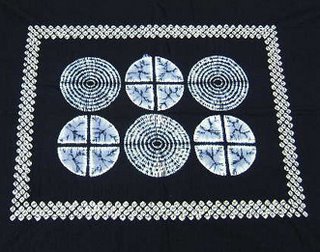Arimatsu & Arimatsu Shibori 有松絞り
 |
| The main street in Arimatsu is flanked with Edo Period style buildings |
Arimatsu, located in Midori-ku in southeast Nagoya in Aichi Prefecture, was once an old Edo-period (1603-1867) post station town on the Tokaido highway between Kyoto and Tokyo.
The Tokaido (lit. "East Sea Road") is Japan's most famous highway and historically links the ancient capital of Kyoto with Edo (present-day Tokyo) along the Pacific coast via Nagoya. The Tokaido officially started in the Nihonbashi area of Tokyo and finished at Sanjo Bridge in Kyoto. Arimatsu lies between the post stations of Narumi-shuku and Chiryu-shuku.
During the Edo Period, the Tokaido inspired the many artists and poets who walked along its route. These included the ukiyo-e artist Hiroshige (1797-1858) who painted the 53 post stations where travelers rested after their day's journey.
 |
| Contemporary shibori |
Nowadays, Arimatsu's main claim to fame is its intricate Arimatsu shibori (tie-dyed fabrics). The technique is used to produce colorful designs for cotton kimonos, yukata, noren, handkerchiefs, table cloths, and even masks and iPhone covers.
It was once sold to travelers on the old Tokaido and is still going strong today.
 |
| Arimatsu traditional wooden building and noren |
Traditional Wooden Architecture
As the industry is still carried on to this day, many of the original merchant houses have been preserved. There are a number of shops and shibori museums where visitors can purchase both traditional and more contemporary tie-dyed products as well as try their hand at producing them.
Arimatsu Narumi Shibori Kaikan is a good place to start.
If you stroll down the main street of the old quarter there are a number of fine, preserved merchant houses, with Nurigome-style, anti-fire, clay coatings, and second-floor latticework windows, including Takeda's house, which are all well worth a look. The original buildings were destroyed by a fire in 1784 and the houses seen today date from after that year when the buildings were rebuilt with thick plaster walls and tiled roofs as a defense against fire.
Buildings of historic interest marked with signboards include the House of Oka, the House of Takeda, the House of Kozuka, and the House of Nakahama.
The contrast between old and modern Arimatsu could not be starker and the station area is dominated by a huge Aeon store and a new elevated highway, the contemporary successor to the old Tokaido, has been constructed just outside the town.
 |
| Arimatsu noren curtain |
Shibori
The technique found its way to the Nagoya area when craftsmen from Oita in Kyushu, skilled in the shibori technique were ordered to help in the construction of Nagoya Castle by the Shogun Tokugawa Ieyasu and later settled in the area. The most influential figure in the history of Arimatsu's tye-dye industry was Takeda Shokuro, whose memorial can be seen just behind the car park of Arimatsu Narumi Shibori Kaikan.
 |
| This tall wooden building (dashiko) holds a festival float - the Karako-sha |
Arimatsu Festival
Arimatsu's colorful festival is held on the first Sunday of October and consists of a street parade with floats and participants in traditional costumes celebrating Arimatsu's history as a shibori center and Tokaido post town since 1608. The floats have mechanical dolls (karakuri) riding on top of them - one of which can even write!
It is also possible to see the impressive festival floats at the Arimatsu Festival Float Museum (Open 10 am-4 pm; closed Wednesday; Tel: 062 621 3000) and in the other large storehouses where they are kept.
 |
| Aya Irodori Atelier |
Shibori Today
As with many Japanese crafts in the 21st century, younger designers are re-inventing traditional designs and motifs. One good example is Aya Irodori Atelier, a third-generation design company dealing mainly in women's fashion. Some designers are also using shibori designs on leather products such as shoes and wallets.
 |
| Arimatsu is an old post town on the Tokaido |
Access - Getting to Arimatsu
Arimatsu Station on the Meitetsu Honsen Line from Nagoya, Horita, or Kanayama stations.
Several buses also stop in Arimatsu. These are the numbers 30, 32, 33 and 34 from Kanayama Station.
 |
| Contemporary shibori |
Arimatsu Related
Shibori Flower Pattern Handkerchiefs
Gallery
 |
| Arimatsu is in Midori-ku, Nagoya - here the building has anti-fire, clay coating |
 |
| Wooden slatted building in Arimatsu, Aichi Prefecture |
 |
| Arimatsu ありまつ noren curtain |
Related
Shichimi Togarashi Seven Spices
© GoodsFromJapan










